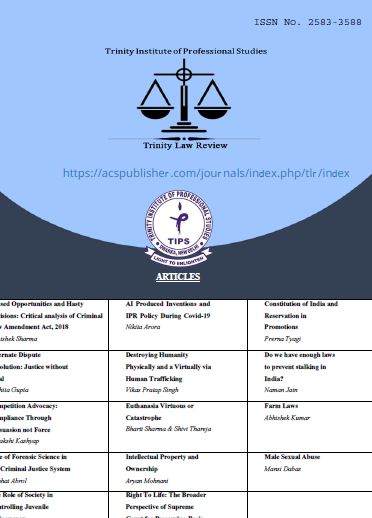India’s Blueprint for Sustainable Growth
DOI:
https://doi.org/10.48165/tlr.2025.5.1.2Keywords:
analyses, infrastruc ture, equity, social, emissionAbstract
This article analyses India’s strategy for attaining sustainable prosperity by 2047, in line with its aspiration to become a developed nation by the 100th anniversary of its independence. It addresses the challenges arising from swift urbanization, industrial growth, and increasing energy requirements, detailing how the Indian government has enacted measures such as the National Action Plan on Climate Change (NAPCC) to tackle these issues. The analysis underscores India’s dedication to minimizing its ecological footprint while promoting economic advancement through clean energy initiatives, technological progress, and infrastructure enhancement. Notable programs like Make in India, Digital India, and Atmanirbhar Bharat are designed to boost domestic manufacturing and self-reliance while fostering sustainability. The vision of Viksit Bharat (Developed India) prioritizes human capital development, the adoption of renewable energy, and international partnerships to achieve net zero emissions by 2070 and to derive 50% of energy from renewable sources by 2030. Furthermore, the document investigates the crucial contributions of green energy, digital innovation, and global collaborations in promoting sustainability. By implementing these cohesive strategies, India seeks to harmonize economic growth, environmental responsibility, and social equity, positioning itself as a frontrunner in sustainable development. This holistic approach aims to secure a resilient and sustainable future for India while supporting global environmental objectives.
References
Ministry of Environment, Forest and Climate Change (MOEF CC), National Action Plan on Climate Change (NAPCC) (Government of India, 2008).
Government of India, Atmanirbhar Bharat: Economic Stimulus Package (Ministry of Finance, 2020).
International Solar Alliance (ISA), Annual Report 2020: Advancing Solar Energy for Sustainable Development (2020).
World Bank, India’s Green Transition: Strategies and Investment Needs (2022).
Ministry of New and Renewable Energy (MNRE), Renewable Energy in India: Achievements and Prospects (Government of India, 2021).
International Energy Agency (IEA), India’s Energy Transition: Poli cies and Pathways to 2047 (2023).
United Nations Development Programme (UNDP), India’s Path to Achieving the SDGs by 2030: A Review of the National Policy Framework (2020).
India Brand Equity Foundation (IBEF), Make in India: The Path to Self-Reliance and Economic Growth (2021).




